 Indians Archive
Indians Archive  Cleveland Indians Top 50 Prospects: 16-20
Cleveland Indians Top 50 Prospects: 16-20
That's right, sports fans. We're into the top 20 prospects in the Cleveland Indians organization. As such, we're going to build the suspense a little and start  releasing these babies 5 at a time instead of 10. We're still closing in on #1 overall (hint: he's an INF that switched positions coming out of college), and that will finally be revealed next Tuesday. We get some local flavor here in the top 20, with a St. Ed's product that projects to be an impact bat and defender behind the dish. We'll also take a look at a trio of lefthanded arms with high upside, and a power reliever from the Far East. As always, here's a link to the intro and prospects #41-50, as well as #31-40 and #21-30 in case you missed them.
releasing these babies 5 at a time instead of 10. We're still closing in on #1 overall (hint: he's an INF that switched positions coming out of college), and that will finally be revealed next Tuesday. We get some local flavor here in the top 20, with a St. Ed's product that projects to be an impact bat and defender behind the dish. We'll also take a look at a trio of lefthanded arms with high upside, and a power reliever from the Far East. As always, here's a link to the intro and prospects #41-50, as well as #31-40 and #21-30 in case you missed them.
20. Chen Lee, RHP
DOB: 10/21/1986
Height/Weight: 5-11/175
Bats/throws: R/R
Acquired: International FA in 2008
2010 Stats: 5-2, 3.22 ERA, 82 K and 22 BB in 72 2/3 IP
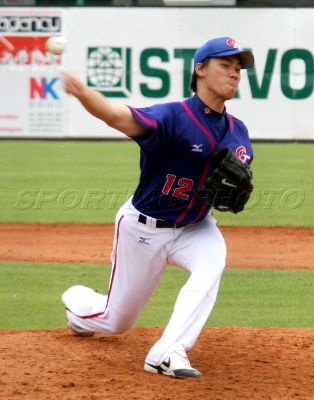 Scouting report: Over the past two seasons, Lee has quietly become one of the better relief prospects in a system loaded with power relief prospects. Lee throws from a three-quarters to almost sidearm arm slot, and the difficult arm angle adds a little extra movement to all of his pitches. He sets everything up with a mid-90s fastball that can get up to 96. Aside from the fastball, Lee also throws a sinker, slider and a changeup. The slider is a swing and miss pitch for him, and he has used it to help rack up 179 K in 156 career IP between high A and AA. His change is kind of a forkball, and has very good down-action. Especially considering the unorthodox arm angle, Lee has outstanding control. He’s walked just 50 batters in those same 156 innings.
Scouting report: Over the past two seasons, Lee has quietly become one of the better relief prospects in a system loaded with power relief prospects. Lee throws from a three-quarters to almost sidearm arm slot, and the difficult arm angle adds a little extra movement to all of his pitches. He sets everything up with a mid-90s fastball that can get up to 96. Aside from the fastball, Lee also throws a sinker, slider and a changeup. The slider is a swing and miss pitch for him, and he has used it to help rack up 179 K in 156 career IP between high A and AA. His change is kind of a forkball, and has very good down-action. Especially considering the unorthodox arm angle, Lee has outstanding control. He’s walked just 50 batters in those same 156 innings.
Before coming over to the U.S., Lee was a member of the Taiwanese national team from 2004-2008. He had a particuarly impressive start against Cuba in 2006, where he went 8 1/3 innings allowing just 2 hits and striking out 6. Signed out of Taiwan as an international free agent in late-2008, Lee made his stateside debut in 2009 with the high A Kinston Indians. He dominated the Carolina League, and earned a ticket to AA Akron for the 2010 season. The Eastern League wasn’t much more of a challenge, as Lee posted very similar numbers in Akron despite the jump in the opposing talent. After the strong season for Akron, Lee was sent to the elite Arizona Fall League, but only pitched 6 innings due to some arm issues. He did strike out 7 in those 6 innings, and put up a 9.00 ERA. For his career, Lee has put up outstanding measurables. In his two-years stateside, Lee has a 10.3 K/9 rate, 2.9 BB/9 rate, and just a 0.6 HR/9 rate.
Lee should begin 2011 in the bullpen for AAA Columbus. He has as good of a chance as any of the plethora of AAA arms to be called up to Cleveland at some point in 2011.
19. Scott Barnes, LHP
DOB: 9/05/1987
Height/Weight: 6-4/185
Bats/throws: L/L
Acquired: For Ryan Garko in 2009. Originally an 8th round pick of the Giants in 2008.
2010 Stats: 6-11, 5.22 ERA, 127 K and 58 BB in 138 IP for AA Akron.
Scouting report: Barnes is a tall lefty with plus velocity that can miss bats. And we picked him up straight up for Ryan Garko. I repeat; we picked him up in a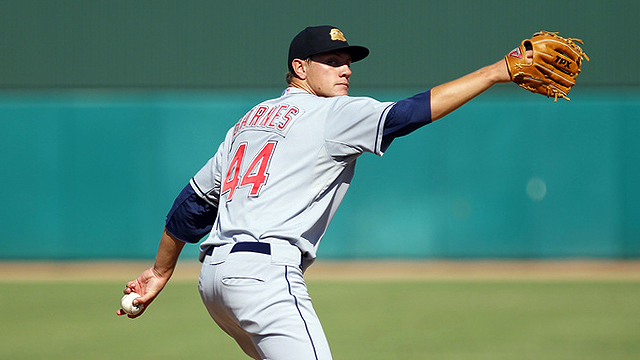 trade up for Ryan Garko straight up. He has a solid but not electric fastball that sits in the low-90s and can touch 95. His best pitch is probably his changeup, which already grades out as a plus pitch. In addition to the fastball and change, Barnes throws a slider which is a little behind the change, but is rapidly improving. The Indians sent Barnes to the Arizona Fall League after the 2010 season primarily to work on the slider, and it paid off in a big way. Pitching in a notorious hitters league, Barnes tied for the league lead in wins with 4 and was 3rd in the league with 28 K. He posted a 3.65 ERA in 24 2/3 innings and gave up a total of 10 ER, 5 of which scored in his first start of the season. The league ERA was 5.08, so that makes that 3.65 mark even more impressive.
trade up for Ryan Garko straight up. He has a solid but not electric fastball that sits in the low-90s and can touch 95. His best pitch is probably his changeup, which already grades out as a plus pitch. In addition to the fastball and change, Barnes throws a slider which is a little behind the change, but is rapidly improving. The Indians sent Barnes to the Arizona Fall League after the 2010 season primarily to work on the slider, and it paid off in a big way. Pitching in a notorious hitters league, Barnes tied for the league lead in wins with 4 and was 3rd in the league with 28 K. He posted a 3.65 ERA in 24 2/3 innings and gave up a total of 10 ER, 5 of which scored in his first start of the season. The league ERA was 5.08, so that makes that 3.65 mark even more impressive.
Barnes struggled with Akron in 2010, but was just 22 years old as a starting pitcher in AA. His peripherals were all solid, and I think both his record and ERA were not reflective of the overall job he did on the mound. His WHIP was 1.333, K/9 was 8.3 and BB/9 was a not good but not horrible 3.8. He did give up 15 HR, which equals the 15 he gave up in his nearly 200 innings prior to 2010. If Barnes does just a little bit better job of keeping the ball in the ballpark, he’s a great candidate to break out in 2011.
Barnes will have a chance to establish himself as the ace of the Akron staff in 2011. I think he will ride the wave of his outstanding AFL performance and put together a solid season, and likely be pitching in Columbus before the end of 2011.
Glass half-full: Barnes sharpens his slider, throws more strikes and becomes a solid piece in the middle of a MLB rotation.
Glass half-empty: Barns slider never turns into even an average MLB pitch, and he ends up in the bullpen as a LOOGY.
18. Nick Hagadone, LHP
DOB: 1/1/1986
Bats/throws: L/L
Acquired: As part of the Victor Martinez deal in 2009. Originally a 1st round sandwich pick of the Boston Red Sox in 2007
2010 Stats: 3-5, 1 SV, 3.57 ERA with 89 K and 63 BB in 85 2/3 IP between high A and AA
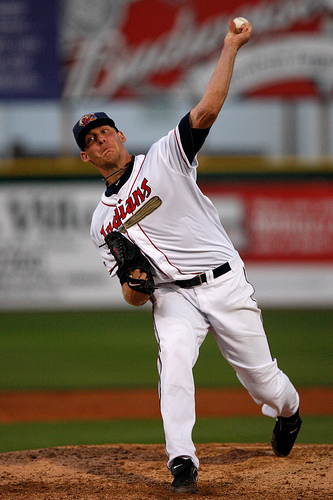 Scouting report: Picked up in the trade that sent Victor Martinez to the Red Sox, Hagadone is a power lefty with a spotty injury history. He has a fastball that sits regularly between 94-97 and has touched 99. The pitch is his bread and butter, and he’s never afraid to attack hitters with his heat. In addition to the fastball, he throws a power slider and a changeup. The slider is a plus pitch and is further along at this point than the changeup, but both pitches project as average to plus down the road. He has drawn comparisons to Billy Wagner from scouts in the past because of his arm strength, sinking fastball, aggressive mentality on the mound and the number of strikeouts he’s able to rack up.
Scouting report: Picked up in the trade that sent Victor Martinez to the Red Sox, Hagadone is a power lefty with a spotty injury history. He has a fastball that sits regularly between 94-97 and has touched 99. The pitch is his bread and butter, and he’s never afraid to attack hitters with his heat. In addition to the fastball, he throws a power slider and a changeup. The slider is a plus pitch and is further along at this point than the changeup, but both pitches project as average to plus down the road. He has drawn comparisons to Billy Wagner from scouts in the past because of his arm strength, sinking fastball, aggressive mentality on the mound and the number of strikeouts he’s able to rack up.
The issue with Hagadone is not his stuff, it is his command and his health. He’s only thrown 165 innings as a pro since his debut in 2007, which is less than a normal starter’s workload in a single season. He has already had Tommy John surgery, and his control hasn’t come all the way back since the operation. The Indians tried to keep Hagadone in the starting rotation in 2010, but his high pitch counts and command issues convinced them to move him to the bullpen. He’s an intense competitor who can occasionally lose his cool on the hill or in the dugout after rough innings.
Hagadone will likely begin 2011 in the AA Akron bullpen. If he can shore up his command, he’ll have a chance to move quickly through the system and could wind up in Cleveland before the end of the year. He’s already 25, so 2011 is a make or break year in his development as an impact arm at the MLB level. There’s no doubt that the talent is there, as left arms like his don’t come along very often. If he can bounce back from a rough 2010, he has the talent to be a closer in the major leagues.
Glass half-full: Hagadone regains his control and validates the Billy Wagner comps that were put on him early in his career.
Glass half-empty: He continues to struggle with his command and emotions and becomes just another bullpen arm.
17. Kelvin De La Cruz, LHP
DOB: 8/1/1988
Height/Weight: 6-5/190
Bats/throws: L/L
Acquired: International FA in 2006
2010 Stats: 7-8, 5.01 ERA, 105 K and 72 BB in 127 2/3 IP between high A and AA.
Scouting report: De La Cruz has as much upside as any pitcher in the Indians system. He brings low to mid-90s heat from the left side, and his fastball has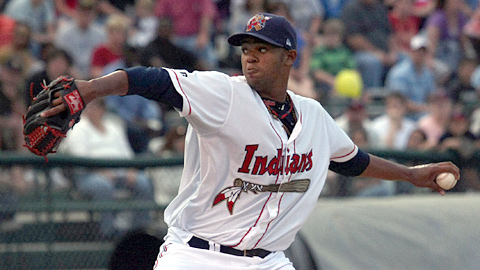 natural sink to it similar to what you see out of a guy like Fausto Carmona. He throws a true 12-6 curveball that already grades out as a plus pitch and should get even better. The third weapon in his arsenal is a changeup that can be good, but isn’t quite as consistent as it needs to be at this point. But he’s a handful for minor league hitters with just his fastball and curveball. He is frequently compared to Carmona due to his stuff, body type and the fact that both hail from the Dominican Republic.
natural sink to it similar to what you see out of a guy like Fausto Carmona. He throws a true 12-6 curveball that already grades out as a plus pitch and should get even better. The third weapon in his arsenal is a changeup that can be good, but isn’t quite as consistent as it needs to be at this point. But he’s a handful for minor league hitters with just his fastball and curveball. He is frequently compared to Carmona due to his stuff, body type and the fact that both hail from the Dominican Republic.
De La Cruz was one of the Indians top pitching prospects heading into 2009, and he began the season as expected in high A Kinston. He started two games, gave up just 2 ER and struck out 19 batters in 12 IP for the K-Tribe. But he felt some pain in his throwing elbow, and it got to the point where the Indians decided to shut him down with a strain of his UCL. It never got to the point where surgery was required, but he missed practically the entire 2009 season as a result. The Indians started him in Kinston again in 2010, where he performed well in 6 starts before moving up to Akron. AA was more of a challenge, as he walked 64 batters in 93 2/3 innings in the Eastern League. Coming off of a serious and scary elbow injury, it was expected that he would have some issues with his control. He has averaged 4.6 BB/9 for his career, so control has always been an issue. I was more concerned with seeing if his elbow could handle a starter’s workload in 2010 than setting any sort of performance metrics for him.
De La Cruz should start of 2011 in the rotation at AA Akron. He’ll be just 22 for most of the baseball season, so he’s still on or ahead of the prospect curve despite the season lost to injury. If he can clean up the walks, refine his control and turn the changeup into a decent offering, he’ll be one of the top breakouts for the system in 2011 and a guy who could be a top 100 overall prospect in all of baseball. However, like his “big brother” Fausto, if he continues to struggle with control and put guys on base without swinging the bat, he’ll never make it past AAA. Very high ceiling, but right now he also has a pretty low floor.
Glass half-full: De La Cruz becomes a lefthanded version of good Fausto.
Glass half-empty: De La Cruz becomes a lefthanded version of bad Fausto.
16. Alex Lavisky, C
DOB: 1/13/1991
Height/Weight: 6-1/200
Bats/throws: R/R
Acquired: 8th round pick in 2010
2010 Stats: .200/.200/.200 for rookie AZL Indians (15 at bats)
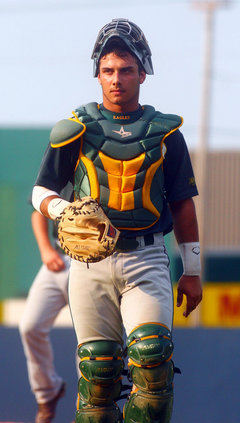 Scouting report: Lavisky is a local kid, having played for Cleveland’s own St. Ed’s high school. Drafted straight out of high school in the 8th round, his goal is now to play for his hometown team just down the road at the corner of Carnegie and Ontario. Most catchers, especially when drafted out of high school, have an incredibly steep learning curve when it comes to the defensive side of the game. Major league pitchers are obviously far more advanced than their high school counterparts. With Lavisky though, that learning curve won’t be quite as steep thanks to his high school battery mate Stetson Allie. Allie was drafted at the beginning of the 2nd round by Pittsburgh and given first round money to sign. By all accounts, Allie threw as hard if not harder than anyone in the 2010 draft. Lavisky is used to catching mid-90’s heat and handling pitches in the dirt from a guy that sometimes struggled with his control. He also has experience handling a talented guy like Allie from the mental side of the house, something that cannot be overlooked when you think about how he is going to be responsible for shepherding a young pitching staff through the growing pains of becoming professionals. He has a strong throwing arm and a pretty good release that will likely have to get a little quicker.
Scouting report: Lavisky is a local kid, having played for Cleveland’s own St. Ed’s high school. Drafted straight out of high school in the 8th round, his goal is now to play for his hometown team just down the road at the corner of Carnegie and Ontario. Most catchers, especially when drafted out of high school, have an incredibly steep learning curve when it comes to the defensive side of the game. Major league pitchers are obviously far more advanced than their high school counterparts. With Lavisky though, that learning curve won’t be quite as steep thanks to his high school battery mate Stetson Allie. Allie was drafted at the beginning of the 2nd round by Pittsburgh and given first round money to sign. By all accounts, Allie threw as hard if not harder than anyone in the 2010 draft. Lavisky is used to catching mid-90’s heat and handling pitches in the dirt from a guy that sometimes struggled with his control. He also has experience handling a talented guy like Allie from the mental side of the house, something that cannot be overlooked when you think about how he is going to be responsible for shepherding a young pitching staff through the growing pains of becoming professionals. He has a strong throwing arm and a pretty good release that will likely have to get a little quicker.
Lavisky is no slouch with the stick either, and has as much raw power as anyone in the system. He’s an athletic kid who should be able to contribute to a team both at and behind the plate. He’s a little older than most players who are drafted out of high school, as he recently turned 20. He spent some time with Lake County at the tail end of the 2010 season, and will likely being his professional career there just minutes from his hometown of Lakewood. It cost the Indians a well-over slot $1 million signing bonus in order to lure Lavisky away from his commitment to play baseball for Georgia Tech, and they’ll be able to look in on their investment without spending much in the way of travel dollars. This ranking is obviously all about projection at this point, and I’m really excited to see Lavisky in Goodyear this spring.
Glass half-full: Way too early to make any kind of prediction/comparison. Let’s see how he handles low-A before we put too much pressure on the kid.
Glass half-empty: He fails at low-A and becomes a Steelers fan.
- NBA Announces 2013-2014 Schedule
- Browns Ink Sharknado
- Sharknado A No-Show For Rookie Camp
- Trent Richardson Out Until Training Camp
- Browns Sign Brandon Jackson
- Carrasco Suspended Eight Games
- Browns Add to Wide Receiver Depth with David Nelson
- Browns Need to Learn from Past Draft Mistakes
- Browns Release Chris Gocong and Usama Young
- Browns Missing on Grimes Disappointing, But Not The End
The TCF Forums
- Chris Grant's first 3 drafts
Kingpin74 (Tuesday, January 21 2014 10:13 AM) - The 2014 Offseason Thread
googleeph2 (Tuesday, January 21 2014 9:36 AM) - 2015 Recruiting
furls (Tuesday, January 21 2014 6:57 AM) - Mike Brown
YahooFanChicago (Monday, January 20 2014 11:15 PM) - Movies coming out
HoodooMan (Monday, January 20 2014 9:34 PM) - 2014 Hoops Hockey Hijinx
jpd1224 (Monday, January 20 2014 4:44 PM) - 2014 Recruiting
jclvd_23 (Monday, January 20 2014 2:26 PM) - Wish List - #4 Pick
Hikohadon (Monday, January 20 2014 1:26 PM) - Official- Browns Coach Search/Rumors
OldDawg (Sunday, January 19 2014 6:48 PM) - #1 overall pick Anthony Bennett
TouchEmAllTime (Sunday, January 19 2014 1:28 PM)



